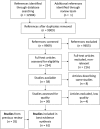Effectiveness of workplace interventions in the prevention of upper extremity musculoskeletal disorders and symptoms: an update of the evidence
- PMID: 26552695
- PMCID: PMC4717459
- DOI: 10.1136/oemed-2015-102992
Effectiveness of workplace interventions in the prevention of upper extremity musculoskeletal disorders and symptoms: an update of the evidence
Abstract
The burden of disabling musculoskeletal pain and injuries (musculoskeletal disorders, MSDs) arising from work-related causes in many workplaces remains substantial. There is little consensus on the most appropriate interventions for MSDs. Our objective was to update a systematic review of workplace-based interventions for preventing and managing upper extremity MSD (UEMSD). We followed a systematic review process developed by the Institute for Work & Health and an adapted best evidence synthesis. 6 electronic databases were searched (January 2008 until April 2013 inclusive) yielding 9909 non-duplicate references. 26 high-quality and medium-quality studies relevant to our research question were combined with 35 from the original review to synthesise the evidence on 30 different intervention categories. There was strong evidence for one intervention category, resistance training, leading to the recommendation: Implementing a workplace-based resistance training exercise programme can help prevent and manage UEMSD and symptoms. The synthesis also revealed moderate evidence for stretching programmes, mouse use feedback and forearm supports in preventing UEMSD or symptoms. There was also moderate evidence for no benefit for EMG biofeedback, job stress management training, and office workstation adjustment for UEMSD and symptoms. Messages are proposed for both these and other intervention categories.
Keywords: Prevention; Review; Upper Extremity; Workplace.
Published by the BMJ Publishing Group Limited. For permission to use (where not already granted under a licence) please go to http://www.bmj.com/company/products-services/rights-and-licensing/
Figures
References
-
- Schneider E, Irastorza X. OSH in figures: work-related musculoskeletal disorders in the EU—facts and figures. Luxembourg: European Agency for Safety and Health at Work (EU-OSHA), 2010.
-
- Silverstein B, Evanoff B. Musculoskeletal disorders. In: Levy BS, Wegman DH, Baron SL, et al., eds Occupational and environmental health: recognizing and preventing disease and injury. New York, NY: Oxford University Press, 2011:335–65.
-
- Workers Compensation Board of Manitoba. Annual report 2009 Winnipeg, MB: Workers Compensation Board of Manitoba, 2010.
-
- Workplace Safety and Insurance Board (WSIB). Statistical supplement to the 2009 annual report (2009) Toronto, ON: Workplace Safety and Insurance Board (WSIB), 2010.
-
- WorkSafeBC. WorkSafeBC statistics 2009. Vancouver, BC: WorkSafeBC, 2010.
Publication types
MeSH terms
Grants and funding
LinkOut - more resources
Full Text Sources
Other Literature Sources
Medical
Miscellaneous

